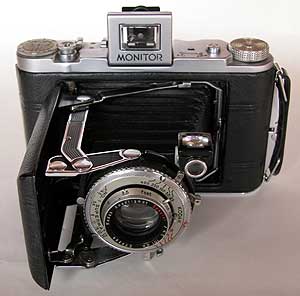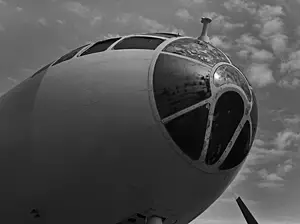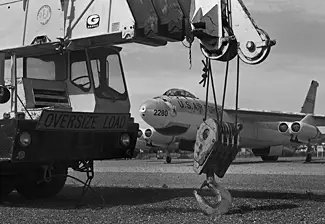Vintage Cameras Index Home



A manual for the Monitor Six-20 and Six-16 models is available on line at the Butkus site.
The lens on my Monitor is the 101mm f/4.5 Anastigmat Special; it is front-focusing, with four elements in three groups. The shutter is the No. 1 Supermatic with speeds from 1 sec. to 1/400 sec. and B. I have the same lens and shutter combination on my Vigilant, so much of these notes also apply to that camera. The main difference from the Vigilant is the metal top plate which houses a film advance and double-exposure prevention mechanism. There is also a pretty little dial-type Depth of Focus scale similar to those found on the Retina I. My Monitor arrived with a new-looking and light-tight bellows, but I think that is rather unusual.
Servicing the lens and shutter is relatively easy on the Monitor. Removing the front lens requires that the little post that stops the focus travel be screwed out. Then, you just unscrew the lens and focus scale; be sure to note the point at which it comes loose so you can get it started right when you go to put it back in.
The next step is a little trickier. The rim of the central lens group projects only a small lip above the surface. This kind of thin-walled brass housing is easily deformed, so it is important to keep pliers and other dangerous tools well away from it. A good tool for getting a grip on the rim of the center lens mount is one of the Flexiclamp wrenches sold by Micro-Tools. I used a 1 3/16" size. Before you start unscrewing the center group, it is a good idea to make a mark crossing the rim to the body so that you can put it back without over-tightening. Also, you will want to note that the group housing comes loose in about one full turn. A friction tool made from a dowel and a piece of rubber will also work.
Once the center lens is out, you can lift off the face of the shutter and get easy access to the internal levers and gears for cleaning with something like Ronsonol lighter fluid. I also removed the back lens group with a lens spanner so as to not get debris on the lens. The whole thing should go back together pretty easily.
Once you've gotten the lens and shutter clean and reassembled, you are ready to shoot pictures, as long as you are comfortable with re-spooling 120 film onto a 620 metal reel. The Kodak engineers went to some trouble to design a camera that will not permit the use of film on a modern 120 spool.
The Monitor user manual advises that the film initially be advanced until the number "1" is just visible in the red window. You are then supposed to move the little lever from "wind" to "1-8" and slightly turn the advance knob which activates the double exposure prevention and moves the "1" into the center of the film frame window. From there you can just crank the knob until it stops without opening the red window for positioning each frame. I initially had some problems with frame spacing but taking off the top, cleaning the mechanism and adding a little lubricant got things straightened out.
The Monitor's sleekly modern design and the nice eye-level finder will propel the user toward camera technique appropriate to a more compact camera. However, that is probably a mistake as the long 101mm lens really demands a thoughtful approach suitable for any of the older medium-format folders. A tripod and a cable release will enhance the chances of success with this camera. It is also important to ignore that pretty depth-of-field dial on the top deck as it is completely inaccurate; hard to imagine what Kodak's engineers were thinking with that feature. Luckily, there are a number of good depth-of-field table gnerators available on the web including a particularly nice one at johnhendry.com.



 © mike connealy
© mike connealy